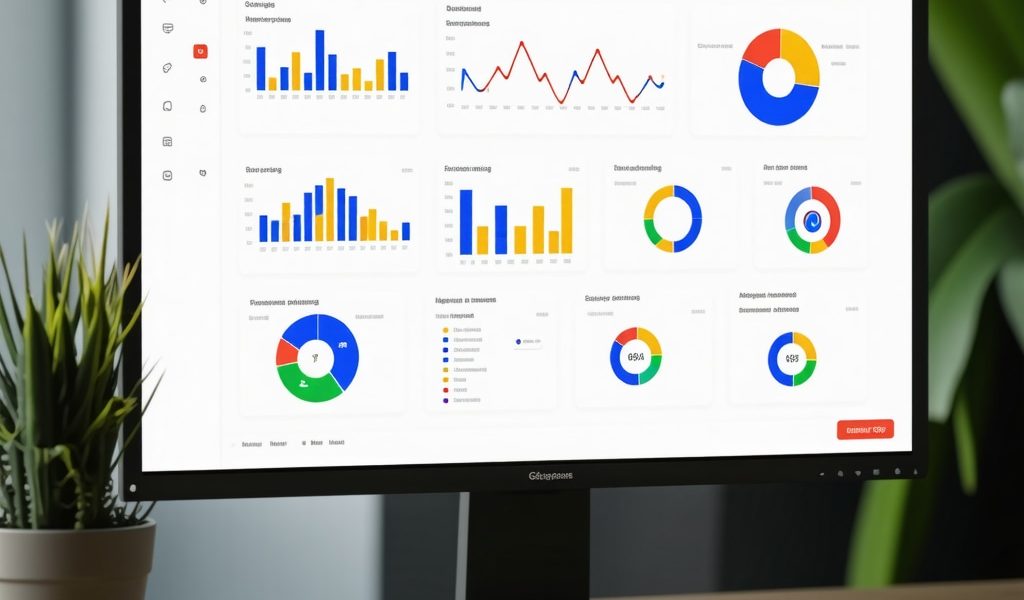Decoding the Nuances of Google My Business Performance Tracking
In an era where local search dominance can dictate business success, comprehensively tracking Google My Business (GMB) performance emerges as a critical strategic imperative. Rather than relying on sporadic checks or superficial metrics, daily monitoring of nuanced GMB data enables marketers and business owners to dynamically adjust tactics, improve engagement, and elevate local visibility with precision. This article unpacks the advanced metrics that seasoned SEO professionals scrutinize daily to extract actionable insights and sustain competitive advantage in the Google Maps ecosystem.
Beyond Basics: Which Key Performance Indicators Reveal True GMB Impact?
While traditional metrics such as views and clicks provide a foundational understanding, expert analysis demands a deeper dive into user behavior patterns and conversion pathways. Engagement metrics including customer actions (calls, direction requests, website visits) reflect tangible user intent and are pivotal for ROI attribution. Likewise, review velocity and sentiment analysis offer critical signals about local reputation health and customer trustworthiness, influencing search rankings algorithmically and perceptually.
How Do Advanced GMB Metrics Correlate with Local Search Rankings?
Recent studies underscore that Google’s local search algorithm leverages a complex interplay of metrics beyond mere citation consistency or keyword presence. The essential GMB performance metrics for 2025 include insights from customer engagement heatmaps and temporal review patterns, which align closely with ranking fluctuations. For instance, an uptick in direction requests during peak business hours can indicate heightened local interest, positively signaling relevance to Google. Furthermore, integrating sentiment analysis tools can detect shifts in review tone that presage ranking changes, enabling preemptive reputation management.
Harnessing Analytical Tools for Real-Time GMB Data Interpretation
To operationalize daily GMB performance tracking, leveraging specialized SEO tools such as BrightLocal or Google’s own Insights dashboard is indispensable. These platforms offer granular data visualization, comparative benchmarks, and alert systems tailored for local businesses. Advanced practitioners often combine these with Google Analytics and CRM data to map GMB interactions directly to conversion funnels, thereby quantifying the true economic impact of local search visibility.
What Are the Best Practices for Integrating GMB Data into Holistic Local SEO Strategies?
Effective integration requires aligning GMB metrics with broader local SEO initiatives, such as citation management, content optimization, and review generation. For detailed methodologies, see our comprehensive guide on mastering Google Business SEO. This synergy ensures that performance insights translate into tactical adjustments, such as optimizing business descriptions with localized keywords or scheduling posts to boost engagement during identified peak hours.
Driving Business Growth Through Proactive GMB Performance Monitoring
Consistent and expert-level tracking of GMB performance metrics empowers businesses to anticipate market shifts, respond to customer feedback promptly, and refine local marketing investments. This proactive approach fosters sustained local search authority and enhances lead generation efficacy, which are crucial in competitive markets.
For SEO professionals seeking to deepen their mastery, exploring advanced content strategies and citation management can amplify these gains significantly. Engage with our expert SEO agency services to unlock tailored solutions that harness the full potential of GMB analytics.
External Source: For empirical analysis on local search ranking factors, refer to the Moz Local Search Ranking Factors Study, which offers a detailed exploration of how various GMB metrics influence Google’s local pack algorithm.
Elevating GMB Success: Leveraging Behavioral Analytics for Strategic Advantage
Understanding raw metrics alone is insufficient for capturing the full scope of Google My Business (GMB) performance. The next frontier lies in behavioral analytics, which dissect how users interact with your profile beyond surface-level clicks and views. For example, analyzing the sequence of actions—such as viewing photos before requesting directions—can reveal consumer intent and preferences, enabling businesses to tailor their listings more effectively.
This nuanced approach allows you to refine your GMB content, emphasizing aspects that resonate most with your target audience. Integrating these insights with comprehensive local SEO strategies, as detailed in our step-by-step GMB optimization guide for 2025, ensures a holistic approach to local search dominance.
Can Advanced User Interaction Metrics Unlock Hidden Growth Opportunities on GMB?
Beyond conventional engagement data, advanced metrics such as click path analysis, dwell time on photos or posts, and frequency of repeat visits provide a window into consumer behavior patterns that directly influence ranking signals. For instance, longer dwell times on your business photos can indicate higher user interest, potentially boosting your profile’s relevance in Google’s algorithm.
Moreover, identifying peak interaction times enables you to strategically publish GMB posts or offers when your audience is most active, enhancing engagement and conversion rates. Such precision timing is crucial for businesses seeking to outperform competitors in saturated local markets.
Integrating Sentiment and Review Analytics for Proactive Reputation Management
Reputation management transcends mere accumulation of positive reviews. Employing sentiment analysis tools to monitor and categorize review content in real-time allows businesses to swiftly address emerging issues or capitalize on positive feedback trends. This proactive stance not only preserves but can also enhance your local search ranking by signaling to Google that your business maintains high customer satisfaction and responsiveness.
Incorporating these insights into your GMB strategy complements citation management and content updates, which are critical components outlined in our detailed guide on managing GMB citations. Such integrated efforts foster authoritative local presence and sustainable ranking improvements.
Harnessing AI and Machine Learning for Predictive GMB Performance Optimization
With the evolution of AI, sophisticated tools now offer predictive analytics that forecast GMB performance trends based on historical data. By anticipating fluctuations in user engagement or review sentiment, businesses can preemptively adjust marketing tactics, refine messaging, or enhance service delivery to maintain optimal local search visibility.
Adopting AI-driven GMB monitoring aligns with innovative SEO practices, enabling a competitive edge through data-backed decision-making. For practitioners interested in exploring these cutting-edge techniques, our resources on fast GMB ranking strategies for 2025 provide actionable insights.
External Source: According to the Search Engine Land article on AI’s role in local SEO optimization, integrating machine learning enhances local ranking accuracy by analyzing complex behavioral and contextual signals that traditional methods may overlook.
Engage with us in the comments below to share your experience or questions about advanced GMB performance tracking, or share this article with peers seeking to elevate their local SEO game.
Deciphering Consumer Intent Through Sequential Interaction Patterns on GMB
Advanced Google My Business (GMB) performance tracking transcends isolated metrics by examining the sequence in which users engage with your profile. For example, a user who browses photos, then reads reviews, and finally requests directions demonstrates a distinct intent path compared to someone who immediately calls the business after viewing the listing. Analyzing these interaction sequences allows businesses to tailor content placement and enhance elements that facilitate smoother conversion journeys. For instance, if data indicates that most users view the photo gallery before clicking on the website, optimizing image quality and descriptive captions becomes paramount.
Moreover, understanding these pathways helps in identifying potential friction points. If users frequently drop off after viewing reviews, it may signal the presence of negative feedback or insufficient response from the business. Acting on such insights by managing reviews proactively or enriching the profile with FAQs can significantly improve user retention and conversion rates.
How Can Sequential User Behavior Analytics Drive GMB Optimization at Scale?
Sequential behavior analytics involves mapping the order and timing of user actions on your GMB listing to model typical customer journeys. When integrated with machine learning algorithms, these data patterns can predict which users are more likely to convert based on their interaction flow. This predictive power enables businesses to customize their GMB content dynamically, such as highlighting promotional posts or updating service hours to match peak interaction phases. Additionally, sequential analytics can inform local ad targeting by identifying micro-moments where potential customers exhibit heightened intent.
For practitioners, tools like Google Analytics 4, enhanced with event tracking tailored to GMB interactions, offer granular insights into these behavioral sequences. Coupling this with CRM data bridges the gap between online engagement and offline conversions, facilitating a comprehensive understanding of the customer lifecycle within local search contexts.
Augmenting GMB Insights with Geospatial and Temporal Data Integration
Incorporating geospatial analytics into GMB performance tracking unlocks a new dimension of local SEO optimization. By analyzing the geographic distribution of users interacting with your listing—down to neighborhood or ZIP code level—businesses can tailor marketing campaigns and promotional offers to hyper-local audiences with pinpoint accuracy. This ensures advertising budgets are allocated efficiently, focusing on areas with the highest engagement potential.
Temporal data integration complements geospatial insights by revealing patterns in user interactions across different times of day, days of the week, or seasonal cycles. Recognizing these trends allows businesses to optimize GMB post scheduling, update business hours, or launch time-sensitive campaigns that align with customer activity peaks. For example, a restaurant discovering a surge in direction requests on weekend evenings might enhance its weekend specials and post timely updates to capture this demand.
Combining geospatial and temporal data fosters a dynamic, responsive local marketing approach, reinforcing the business’s relevance within its community and boosting Google’s perception of its authority.
Exploring AI-Powered Sentiment Analysis: A New Paradigm in Real-Time Reputation Management
Traditional review monitoring is rapidly evolving with the advent of AI-powered sentiment analysis tools that parse nuances beyond star ratings. These systems utilize natural language processing (NLP) to classify reviews based on emotional tone, detect emerging themes, and even predict potential crisis points before negative feedback proliferates. Such granular sentiment insights empower businesses to craft tailored responses that address specific concerns, demonstrating engagement and fostering trust.
Moreover, advanced sentiment models can segment reviews by product, service aspect, or staff member, providing actionable intelligence for targeted improvements. Integrating these insights within GMB performance dashboards creates a real-time feedback loop that informs both operational and marketing decisions.
For example, a service provider noticing a spike in sentiment related to appointment scheduling delays can promptly adjust staffing or communication protocols, mitigating negative impacts on local SEO rankings.
External Source: According to a study by ScienceDirect on AI-based sentiment analysis in customer review management, integrating AI-driven sentiment analysis significantly enhances the speed and accuracy of reputation management, leading to improved customer satisfaction and business performance.
Strategic Implications: Combining Behavioral Analytics, AI, and Local SEO for Competitive Edge
The convergence of behavioral analytics, AI-powered sentiment analysis, and geospatial-temporal data integration represents the cutting edge of GMB optimization. Businesses that harness this triad can anticipate market shifts, personalize customer experiences, and maintain agile local SEO strategies that adapt in real-time. This integrated approach transcends reactive management, positioning enterprises as proactive leaders within their local search ecosystems.
Implementing such complex systems requires both technical expertise and strategic vision, often necessitating collaboration between SEO specialists, data scientists, and local marketing teams. However, the rewards—sustained ranking improvements, elevated brand reputation, and enhanced conversion rates—justify the investment.
To delve deeper into these advanced methodologies and unlock bespoke optimization techniques, explore our specialized resources or connect with our expert consultants who specialize in data-driven local SEO transformations.
Unveiling Predictive Analytics: Anticipating Local Market Dynamics through GMB Data
Moving beyond descriptive metrics, predictive analytics applied to Google My Business (GMB) data empowers enterprises to foresee evolving consumer behaviors and local market fluctuations. By synthesizing time-series trends, sentiment trajectories, and interaction sequences, AI-driven models forecast potential dips or surges in user engagement, allowing preemptive adjustment of marketing initiatives. This anticipatory capability transforms GMB management from reactive to strategic, optimizing resource allocation in anticipation of demand shifts.
How Can Machine Learning Models Be Trained to Predict GMB Engagement and Conversion Outcomes?
Training robust machine learning models for GMB performance prediction entails curating multifaceted datasets encompassing historical interaction logs, temporal patterns, and sentiment scores. Supervised learning algorithms, such as gradient boosting or recurrent neural networks, can capture nonlinear dependencies and temporal correlations inherent in user behaviors. Feature engineering focusing on sequential user paths, geospatial clustering, and review sentiment dynamics enhances model accuracy. Moreover, integrating external socioeconomic indicators—like local events or weather data—can augment predictive fidelity, providing a holistic view of factors influencing consumer engagement.
Tools such as TensorFlow or PyTorch, combined with Google Cloud Platform’s BigQuery ML, facilitate scalable model development and deployment tailored for local SEO analytics. These platforms enable iterative experimentation and real-time inference, essential for dynamically optimizing GMB listings.
Leveraging Multi-Channel Attribution to Quantify GMB’s Role in Omnichannel Customer Journeys
Accurately attributing conversions to GMB interactions within complex omnichannel environments remains a formidable challenge. Advanced attribution modeling incorporates data from CRM systems, call tracking, website analytics, and offline sales to construct a comprehensive picture of customer touchpoints. Employing Markov chains or Shapley value analysis reveals the incremental contribution of GMB engagements relative to other marketing channels.
This granular attribution informs budget allocation decisions and identifies high-impact GMB touchpoints, enabling optimization of content and offers to maximize conversion likelihood. Integrating GMB data with Customer Data Platforms (CDPs) further enhances personalization and customer lifecycle management.
Harnessing Real-Time Anomaly Detection for Proactive GMB Performance Management
Implementing anomaly detection algorithms on GMB performance streams uncovers unexpected deviations indicative of emerging issues or opportunities. For instance, sudden drops in call volume or spikes in negative sentiment may signal operational problems requiring immediate attention. Conversely, unanticipated surges in direction requests or review submissions can highlight viral campaigns or seasonal demand peaks.
Techniques such as Seasonal Hybrid ESD (S-H-ESD) or Long Short-Term Memory (LSTM) networks process temporal data with seasonality and trend components, ensuring sensitive and context-aware anomaly identification. Visualization dashboards integrating these alerts enable rapid response workflows, minimizing reputational risk and capitalizing on emergent trends.
Integrating Voice Search Analytics into GMB Optimization for the Conversational Economy
With the proliferation of voice-activated assistants, optimizing GMB profiles for voice search queries demands nuanced understanding of conversational search intents and natural language variations. Analyzing voice query transcripts and patterns from platforms like Google Assistant or Alexa reveals prevalent question types and local information needs.
Incorporating these insights into GMB content strategy—through FAQ sections, schema markup enhancements, and colloquial keyword targeting—improves voice search visibility and accessibility. Furthermore, leveraging speech recognition APIs combined with GMB interaction data enables fine-tuning of response accuracy and user satisfaction.
External Source: For a comprehensive examination of AI and machine learning applications in local SEO, refer to the Search Engine Land article on AI’s role in local SEO optimization, which details practical implementations and case studies.
Explore these advanced methodologies with us and elevate your GMB management to unparalleled sophistication. Share your insights or inquiries in the comments, or connect with our expert consultants to unlock tailored, data-driven local SEO strategies.

Expert Insights & Advanced Considerations
Embrace Sequential User Behavior Analytics to Uncover Conversion Pathways
Decoding the order in which users interact with your Google My Business profile reveals subtle intent signals that traditional metrics overlook. By analyzing behavioral sequences—such as photo views preceding website clicks—businesses can optimize content placement and user flow, enhancing conversion efficiency. This granular understanding enables tailored enhancements that resonate with user preferences and reduce friction in the customer journey, elevating both engagement and ranking potential.
Integrate Geospatial and Temporal Data for Hyper-Local Targeting
Augmenting GMB performance tracking with location-specific and time-based analytics transforms local SEO from broad strokes into precision marketing. Identifying neighborhood-level engagement hotspots and peak interaction windows empowers businesses to customize promotions and posting schedules. This dynamic approach not only maximizes resource allocation but also strengthens Google’s perception of relevance and authority within the local community.
Leverage AI-Driven Sentiment and Predictive Analytics for Proactive Reputation Management
Advanced sentiment analysis transcends star ratings by interpreting nuanced customer emotions and emerging trends in real-time. Coupled with predictive models forecasting engagement fluctuations, this empowers businesses to act preemptively—addressing potential issues or capitalizing on positive momentum. Incorporating these AI insights into GMB strategies ensures sustained ranking improvements and fosters trustworthiness critical for competitive local search landscapes.
Adopt Multi-Channel Attribution Models to Quantify GMB’s True Impact
Understanding GMB’s role within the broader omnichannel customer journey requires sophisticated attribution techniques. By integrating CRM, call tracking, and web analytics data, marketers can isolate GMB’s contribution to conversions accurately. This clarity guides strategic budget allocation and content optimization, ensuring GMB efforts complement wider marketing initiatives and drive measurable business growth.
Implement Real-Time Anomaly Detection to Maintain Optimal GMB Performance
Deploying algorithms that identify unexpected shifts in GMB metrics—such as sudden drops in calls or spikes in negative reviews—enables swift response to emerging challenges or opportunities. Context-aware detection methods that account for seasonality and trends prevent false alarms, maintaining focus on genuine performance deviations. This vigilance safeguards reputation and maintains consistent local search visibility.
Curated Expert Resources
Moz Local Search Ranking Factors Study: A comprehensive empirical analysis detailing how diverse GMB metrics influence Google’s local search algorithm, essential for understanding ranking drivers.
Search Engine Land – AI in Local SEO: Offers in-depth coverage on machine learning applications in local search optimization, including practical case studies and emerging trends.
ScienceDirect – AI-Based Sentiment Analysis in Customer Review Management: A scholarly resource illuminating the efficacy of NLP-driven sentiment tools in enhancing reputation management and customer satisfaction.
Google Analytics 4 Documentation: A definitive guide to leveraging GA4’s event tracking capabilities for mapping detailed user interactions with GMB listings.
BrightLocal Platform Resources: Specialized tutorials and data visualization tools tailored for granular GMB performance tracking and local SEO benchmarking.
Final Expert Perspective
Mastering Google My Business performance tracking in today’s competitive environment demands a multifaceted approach that transcends simplistic metrics. Integrating behavioral analytics, geospatial-temporal data, AI-powered sentiment analysis, and sophisticated attribution models creates a holistic, proactive strategy. This ensures not only sustained local search dominance but also a deeper understanding of consumer intent and dynamic market conditions. For professionals seeking to elevate their local SEO mastery, engaging with advanced resources and expert consultation—as detailed throughout this article—provides the pathway to meaningful, measurable business growth. We invite you to deepen your expertise by exploring our comprehensive guides, sharing your own insights, or connecting directly with our team for tailored solutions at https://rankingseogmb.com/contact-us.



This article really highlights how crucial it is to move beyond just counting views and clicks when tracking GMB performance. In my experience managing a local service business, the daily monitoring of engagement metrics like calls and direction requests has been a game-changer for understanding actual customer intent. It’s fascinating how applying sentiment analysis to reviews doesn’t just help reputation management but also impacts search rankings, which isn’t always obvious on the surface.
One challenge I’ve noticed is integrating GMB data with CRM and web analytics to create a clear conversion funnel. It takes some technical know-how, but once set up, it allows for far more precise ROI measurement. I’m curious if others have experimented with AI-driven predictive analytics in this space? The idea that machine learning can forecast engagement dips or surges seems promising for proactive marketing adjustments.
Also, the section on sequential user behavior analytics caught my attention—analyzing the order of interactions like photo views before direction requests seems like a subtle yet powerful insight. Has anyone tried reshaping their GMB content based on such behavioral flows, and what impact did that have on conversion rates? I’d love to hear about tools or methods others use to achieve this level of granular analysis.
This article really underscores the importance of a multi-dimensional approach to GMB monitoring, especially when it comes to advanced behavioral analytics. I’ve seen firsthand how analyzing sequence patterns, like which photos are viewed before users request directions, can inform smarter content placement and even influence service adjustments. Implementing such detailed tracking has helped my local business reduce customer friction points significantly.
However, one challenge I encountered was the integration of these granular insights into our existing marketing workflows. It often requires custom dashboards or specialized tools, which can be resource-intensive. Have others found effective, easier ways to automate or simplify these behavioral analyses without extensive technical overhead?
Additionally, I’m curious about balancing real-time data collection with strategic planning. While immediate insights are invaluable, how do you prioritize long-term improvements based on this depth of granular data? Would love to hear examples of how others translate these insights into scalable strategies that drive sustainable growth in hyper-local markets.